To further the current work in progress, I am re-reading Erik Larson’s Isaac’s Storm
– a gripping and almost novelistic account of the hurricane which struck the Texas Gulf coast city of Galveston on Saturday, September 8th, 1900. The Isaac of the title is Isaac Cline, the resident meteorologist in Galveston for the U.S. Weather Bureau – who paid a devastating price – the loss of his heavily pregnant wife when his house was swept away at the height of the storm – for miscalculations made; miscalculations made both by himself and by the Weather Bureau headquarters policies in far-distant Washington DC.
That 1900 storm still stands as the single deadliest natural disaster ever to strike the United States, with a death toll equal of all later storms combined; at least 6,000 in Galveston alone – a quarter of the population at the time – and along the Texas coast. The storm surge went for miles inland, and may have carried away another 2,000, whose bodies were never found – and never reported missing, as there was no one left to do so. Galveston Island – a coastal sand-bar, little more than eight feet above sea level at its highest point – was a busy and strategic port. At the turn of the last century, it was the largest city in Texas; a center of commerce, transportation hub and port of entry for immigrants coming into the Southwest by sea. Galveston was connected to the mainland across a normally placid lagoon by three railway trestles. Although the rival port city of Indianola, farther west along the Gulf Coast had been wiped out by a pair of hurricanes fifteen and twenty-five years before, generally the citizens of Galveston were complacent, comfortable in the belief that any storm – and they had easily weathered many of them – was readily survivable. And after all – this was a new century, one marked by unparalleled technologic and scientific advances! So a sea-wall proposed by certain concerned citizens was never built; indeed, Isaac Cline had written an article for the local newspaper in 1891, arguing that such a wall was not necessary; it was impossible for a storm of sufficient destructive intensity to strike Galveston. And he, of course, was an expert.
And so were the U.S. Weather Bureau experts – and fiercely proud of it, although telegraphic reports of weather
phenomena upon which authoritative forecasts were based tended to be spotty – especially when ocean-going ships and foreign countries were involved. For fear of the “crying wolf” effect the Weather Bureau also frowned on what they held to be overuse of terms such as “hurricane” or “tornado” lest those in the path of a project event be panicked unnecessarily – or to become blasé about such warnings. By the first few days of September, 1900, Isaac Cline’s office in Galveston began to get warnings regarding a tropical storm system moving in a northerly line over Cuba – but forecasters at the bureau believed the storm was moving in a curved, northerly line which would take it across Florida, up the east coast and then out into the Atlantic again. They disregarded predictions by weather observers in Cuba who insisted that the storm system would continue westerly, impacting against the Texas Gulf coast.
The weather was warm, as it always is at this time of the year in Texas – the waters of the gulf were as warm as bathwater. And those existing yet relatively unnoticed conditions were enough to boost the tropical storm to lethal strength. On the morning of Saturday, September 8th, weather conditions seemed like nothing special; partly cloudy skies and heavy if not particularly frightening swells along the outer edge of the island. Perhaps at that point, no one was particularly worried, although in hind-sight, some residents did own to apprehensions. The movie director King Vidor, then just six years old, later wrote of how the water of the lagoon and the sea appeared to mound up on either side of the town by mid-morning as if Galveston were at the bottom of a bowl and the water about to spill over the rim.
And then it began to rain – at first much welcome – the temperature dropped and the winds picked up. Still no one worried, very much. Children were entranced by how the water in streets paved with wooden blocks began to fill with water, which lifted and floated the paving blocks, a sea of bobbing corks. They splashed happily in that water, but by mid-morning, if anyone had begun to be frightened, it was already too late. Water from the gulf-side and the lagoon began flowing in the main streets, sheeting over the raised sidewalks in downtown Galveston. Heavy waves were already falling on the sand shore of the outside of the island, where protective dunes had been scraped away to fill in and level the rest of the island. Gusts of wind began slamming against storefronts with brutal force. Around midday the bathhouses, small restaurants, and souvenir stores along a boardwalk along the Gulf shore known as the Midway began disintegrating under the assault of the surf. People were a bit nervous at seeing the water in the streets rise so swiftly, at the destruction of the Midway – but for most residents, it seemed as if this was just another tropical storm, of which Galveston had weathered so many.
Until the collapse of Ritter’s Café and Saloon, a popular eatery in the heart of Galveston’s commercial district. The café was on the ground floor of a substantial two-story building which housed a print-shop in the second floor. A particularly violent gust of wind ripped off the roof; the sudden decompression apparently bowed the second-story walls sufficiently for the floor beams to pop loose … and the heavy printing presses, beams and fittings of the print-shop crashed down on patrons of the café below. Five diners died instantly, another five injured so badly that the café’s owner sent a waiter for medical help … and the waiter drowned in fast-rising water. The morning train from Houston arrived, with considerable difficulty, inching across the railway trestle that spanned the lagoon, passengers watching nervously as the water washed back and forth under the rails. One of those passengers was David Benjamin, a senior executive of the Fred Harvey Company, who had business to do in town – where Fred Harvey maintained one of their popular rail-station restaurants; Mr. Benjamin had an appointment in town and went to make it, although to his exasperation, the man he was to meet did not. Mr. Benjamin returned to the Harvey House – considerably sobered by the sight of the body of a dead child, washing into the railway station.
The second scheduled train, from Beaumont City, never even got that far, being stymied on arrival at the ferry landing, where a barge would carry the entire train; engine, coaches and all – from Bolivar Point across to the Island. The water was too violent for the captain of the ferry to dock and run the train onto it. The train reversed, going back the way it came, until stranded by rising water near to where the Point Bolivar Lighthouse stabbed a lonely finger into the sky. The inhabitants of Point Bolivar – all two hundred of them – had already taken refuge in the lighthouse, crammed two and three onto the narrow spiral staircase inside that stout tower. Ten passengers from the train braved the winds and increasingly higher waters, slogging the quarter mile or so in the flat open plain to join them, saving their own lives thereby, for the storm surge eventually overwhelmed the train; the remaining passengers and crew all were lost.
By the middle of afternoon, anyone paying attention already suspected that things were about to get very, very bad. One of Mr. Benjamin’s fellow passengers taking shelter in the railway station had a pocket barometer in his luggage, and commenced to take readings, as his barometer – and that at Isaac Cline’s weather station on the roof of the Levy building began to fall, and fall, and fall even farther, to the point where some observers began to think the instruments must be defective. Long afterwards, weather experts estimated the winds to have blown at 150 miles per hour with gusts reaching 200. There was no way to be certain, as the Weather Bureau’s anemometer and rain gage were blown off the top of the Levy Building and destroyed early in the evening. The sky turned so dark that it seemed to some as if dusk had already fallen. The wind whipped slate tiles as if they were shrapnel. At about two in the afternoon, the wind shifted from a northerly direction to the northeast; over the next hours, the water came up and up, higher and higher, driving people into the second floor of whatever they had taken refuge in – assuming that they had a second floor. The streets and gardens of Galveston became seas, studded with wooden flotsam and wreckage … and just short of seven in the evening the water came up four feet in as many seconds. The meticulous observer Isaac Cline noted the rise of water against the dimensions of his own house, calculating that it was now over fifteen feet deep and still rising. But he was certain that his house would withstand the storm, constructed as it was on deep-driven pilings.
Unfortunately, he had not considered the effect of the storm – wind and water between them driving an irresistible
moraine of debris into the residential area where his house stood – lumber and wreckage from other houses, reinforced with heavy timbers from the destroyed Midway, iron street-car rails, and uprooted trees. Every fresh wave pounded that mass farther and farther inland, a leviathan grinding up and adding more wreckage to the mass, until it towered almost two stories tall and stretched across the middle of town. Eventually, it overwhelmed the Cline residence, throwing Isaac, his wife and three daughters and his younger brother who also worked at the Weather Bureau into the turbulent water. They all survived, save Mrs. Cline, whose body was unearthed three weeks later. The merciless waves also destroyed the orphanage a little north of town, run by the Ursuline sisters; smashing the range of buildings, as the ten nuns herded the children into the upstairs dormitory farthest from the seashore. Each sister had lashed seven or eight children to themselves with clothesline, all in a line like ducklings after their mother, in a vain attempt to keep them together and safe, but the sea came into that last refuge and the only orphans to survive were three older boys who managed to scramble into a tree. At least 3,600 buildings were smashed, leaving those fortunate enough to survive without much shelter when Sunday morning came – a calm and mild day, considering the fury of the night before.
The bridges to the mainland were gone, the telegraph lines destroyed, it took a small delegation of local men, traveling in one of the few ships in port which had survived the storm to limp across the bay and travel up to Houston, from where they could send telegrams to the governor, and the president of the US. Residents of Houston had already surmised the need for help, and sent rescue parties to Galveston. The first train to try reaching Galveston could come no closer than six miles from shore, reporting that the coastal prairie was strewn with debris and corpses, and a large steamship stranded two miles inland.
Galveston did rebuild, of course. The seawall first suggested and rejected after the destruction of Indianola was constructed; sand was dredged from the bay and used to raise the level of the island nearly twenty feet. With a great deal of trouble and effort, 2,100 of the surviving buildings were elevated. All of this proved their worth when another hurricane struck dead on in 1915, with comparatively minor casualties. But dredging of the Houston Ship Channel to accommodate ocean-going ships spelled doom for Galveston as an important player in commerce and shipping. It’s still a nice seaside town, historic as all get-out, and with a pleasing situation – but not half the place it was on September 7, 1900.

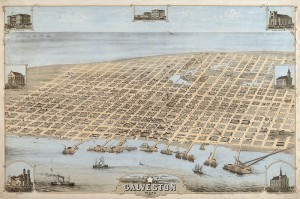
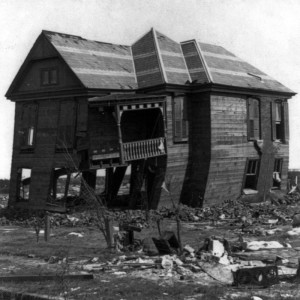
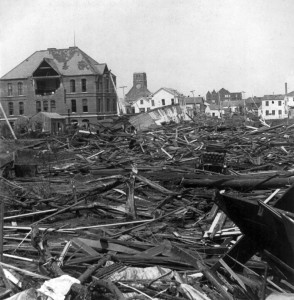
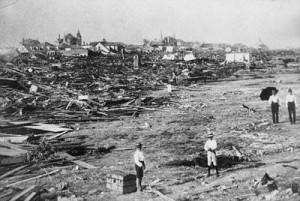
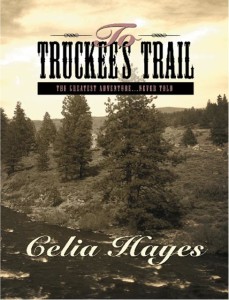
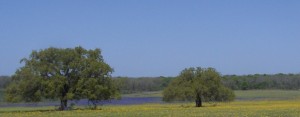
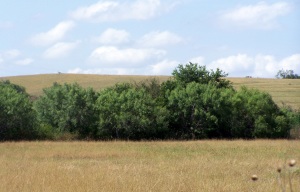
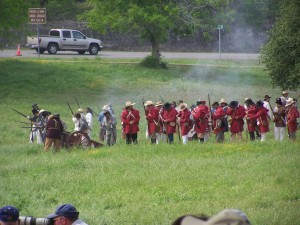
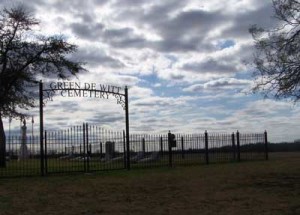
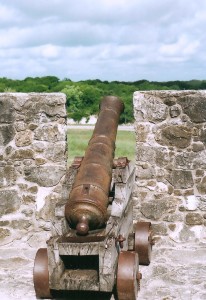
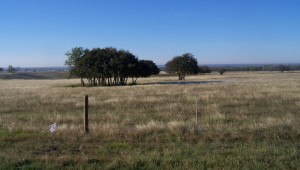
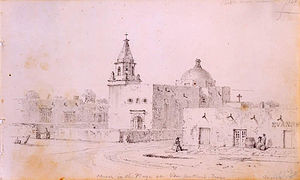
Recent Comments